
HSBC Main Building is a headquarters building of The Hongkong and Shanghai Banking Corporation, which is today a wholly owned subsidiary of London-based HSBC Holdings. It is located on the southern side of Statue Square near the location of the old City Hall, Hong Kong. The previous HSBC building was built in 1935 and pulled down to make way for the current building. The address remains as 1 Queen's Road Central.
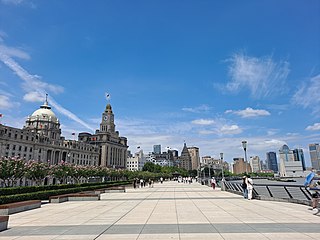
The Bund is a waterfront area and a protected historical district in central Shanghai. The area centers on a section of Zhongshan Road within the former Shanghai International Settlement, which runs along the western bank of the Huangpu River in the eastern part of Huangpu. The area along the river faces the modern skyscrapers of Lujiazui in Pudong. The Bund usually refers to the buildings and wharves on this section of the road, as well as some adjacent areas. This region has a significant European influence, with the style of many structures most comparable to that of European cities, particularly Gothic, Baroque, Neoclassical, Romanesque, Art Deco, and Renaissance architecture. Additionally, some of the city's top eateries are located there. From the 1860s to the 1930s, it was the rich and powerful center of the foreign establishment in Shanghai, operating as a legally protected treaty port.

Bank of Communications is the fifth-largest bank in mainland China. It was originally established in 1908 and was one of a handful of domestic Chinese banks that issued banknotes in modern history. Following the Chinese Communist Revolution in 1949, the mainland operation of that bank were merged into the People's Bank of China and People's Construction Bank of China under the Communist single-tier banking system, while its continuation in Taiwan eventually became part of Mega International Commercial Bank.
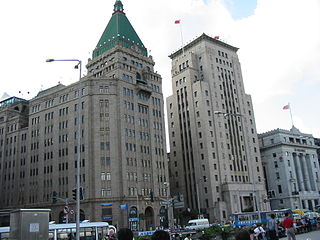
The Bank of China Building is a tower located at No. 23 on the Bund, in Shanghai, People's Republic of China. Previously the headquarters of the Bank of China, it now houses the Shanghai Branch of the Bank of China.

The Broadway Mansions is a nineteen-floor Art Deco five-star hotel in Shanghai, China. and was for over five decades one of the primary symbols of Shanghai.

The HSBC Building is a six-floor neo-classical building in the Bund area of Shanghai, China. It served as the headquarters of the Shanghai branch of The Hongkong and Shanghai Banking Corporation from 1923 to 1955, and currently houses the Shanghai Pudong Development Bank. The building is situated at number 12, the Bund. Designed by the British architecture firm Palmer & Turner Architects and Surveyors, construction of the building lasted from 5 May 1921 to 23 June 1923.
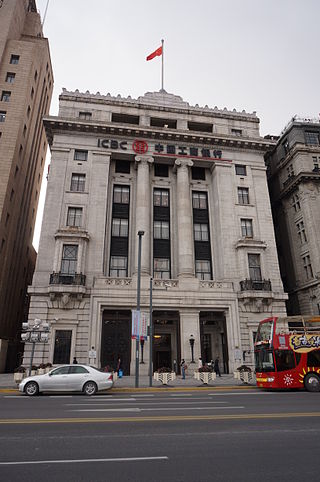
The Yokohama Specie Bank Building is a seven-story building in The Bund, Shanghai, China; previously it was a branch of Yokohama Specie Bank. It is now a reginoal branch of the Industrial and Commercial Bank of China (ICBC).

Shanghai Club Building (上海总会大楼) is a six-storey Baroque Revival building at The Bund, Huangpu, Shanghai, China. It was originally constructed in 1864 and opened in 1911, and was designated as a major cultural heritage site under national-level protection. Currently, it is operated by the Waldorf Astoria Shanghai on the Bund.

The Asia Building, also known as the McBain Building, the Asiatic Petroleum Building, and more recently as Bund One, is a historic eight-storey building on the Bund in Shanghai, China.

The Russo-Chinese Bank Building, later known as the Central Bank Building is a historical building on the Bund in Shanghai, China.
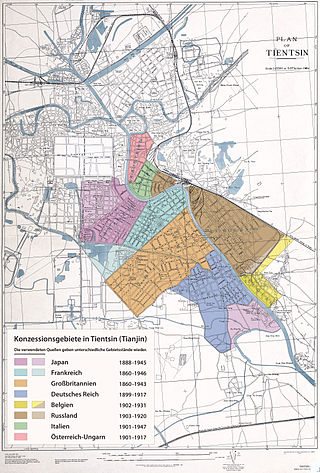
The foreign concessions in Tianjin were concession territories ceded by Qing China to a number of European countries, the United States and Japan within the city of Tianjin. There were altogether nine foreign concessions in old Tianjin on the eve of World War II. These concessions also contributed to the rapid development of Tianjin from the early to mid-20th century. The first foreign concessions in Tianjin were granted in 1860. By 1943, all the foreign concessions, except the Japanese concession, had ceased to exist de facto.

The Union Building is a building on the Bund in Shanghai, China. It is located at No. 3, the Bund.

The North China Daily News Building is a historical Neo-Renaissance-style office building on the Bund in Shanghai, China located at No.17, The Bund. It currently houses the offices of the American International Assurance (AIA), and is thus often called the AIA Building. At the time of its opening in 1924, it was the tallest building in Shanghai.

The Deutsch-Asiatische Bank was a foreign bank in Asia, founded in 1889 in Shanghai. Its principal activity was trade financing, but together with English and French banks, it also played a role in the underwriting of bonds for the Chinese government and in the financing of railway construction in China.
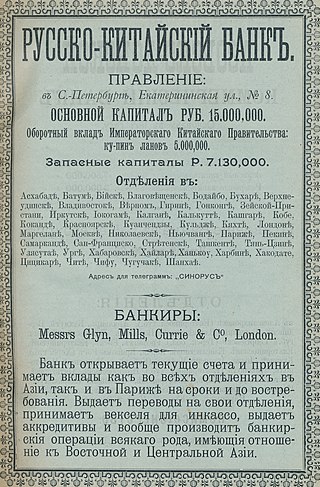
The Russo-Chinese Bank was a foreign bank, founded in 1895, that represented joint French and Russian interests in China during the late Qing dynasty. It merged in 1910 with the French-sponsored Banque du Nord, a large domestic bank in Russia, to form the Russo-Asiatic Bank.

Yokohama Specie Bank was a Japanese bank, founded in Yokohama, Japan in 1880. In 1946, it was reorganized and rebranded as the Bank of Tokyo, later part of MUFG Bank.

The modern buildings on Zhongshan Square in Dalian refer to the buildings on Zhongshan Square in Dalian, Liaoning Province, China, built mostly in the first half of the twentieth century, during which time Dalian was Japan's leased territory.
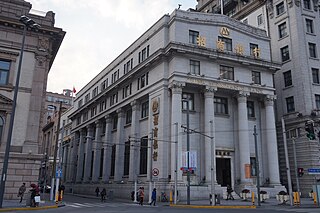
The Bank of Taiwan Building is located at No. 16, The Bund, Shanghai, China. The Japanese Empire occupied Taiwan in 1895, and in 1899 founded the Bank of Taiwan to promote trade between Taiwan, the Japanese Empire, and the rest of Asia. The bank then began opening offices outside of Taiwan in order to facilitate inter-regional trade.

The Nissin Building is a six-storey building on the Bund, Shanghai, China.

The Glen Line Building, also known as the United States Information Agency Building or Shanghai People's Radio Station Building, is a 7-floor building in Shanghai, China, which was built in the former Shanghai International Settlement in 1922. It was designed by architect George Leopold Wilson of the Palmer and Turner Hong Kong. It is a 'major cultural heritage site under national-level protection', and also an 'outstanding historic building' of Shanghai.





















